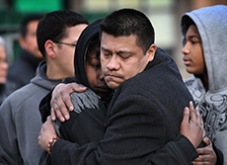Reducing Gun Violence: What Can Be Done Now
Communities, schools, employers, and cities can act to reduce gun violence even while waiting for laws to be passed. In addition to raising awareness of behavior that might predict self-harm or harm to others, innovative programs are addressing issues at the community level and in schools and workplaces.
How the Safe and Successful Youth Initiative (SSYI) Decreased City-Level Youth Crime Victimization Rates
Published in the Journal of MultiDisciplinary Evaluation, this article summarizes the results of a quasi-experimental evaluation that indicate the SSYI program had a statistically significant and positive impact on reducing the number of victims of violent crimes, aggravated assaults, and homicides reported to the police per month.

The Roots of Urban Gun Violence - PDF│Video
Read Patricia Campie's remarks at the Congressional Briefing on Violence and Violence Prevention, held by the Center for Evidence-Based Crime Policy, in collaboration with WestEd’s Justice & Prevention Research Center, on Tuesday, September 27, 2016 in Washington, D.C.
 Long Story Short: How Do We Prevent Gun Violence?
Long Story Short: How Do We Prevent Gun Violence?
The U.S. has more guns and more homicide deaths per capita than any other nation in the world. In this video interview, Patricia Campie talks about what everyone can do to prevent gun violence.
Commentary: What Can We Do About Gun Violence While We Wait for Congress to Act?
What can be done right now to prevent firearms violence—from suicide, to rampages by those who are mentally ill, to acts of terrorism—without heavy reliance on the federal government? Patricia Campie suggests what states, cities, employers, and communities can do.
Programs Reaching Out to Youth
Safe and Successful Youth Initiative in Massachusetts (SSYI)
SSYI combines health and safety approaches toward the goal of eliminating serious violence among high-risk, urban youth.
- Understanding the Influence of Outreach, Case Management, and Service Engagement on Interrupting Community Violence (February 2022)
- Massachusetts’s Safe and Successful Youth Initiative (SSYI) Continues to Reduce Violent Crime and Improve Lives (June 2020)
- Community-Based Violence Prevention Study of the Safe and Successful Youth Initiative: An Intervention To Prevent Urban Gun Violence
- The Impact of the SSYI on City-Level Youth Crime Victimization Rates
- A Comparative Study Using Propensity Score Matching to Predict Incarceration Likelihoods Among SSYI and non-SSYI Youth from 2011-2013 (PDF)
- Massachusetts Safe and Successful Youth Initiative: Benefit-to-Cost Analysis of Springfield and Boston Sites (PDF)
Striving to Reduce Violence in Neighborhoods Through Community Engagement
STRYVING (Striving to Reduce Violence in Neighborhoods Through Community Engagement) will enhance the ability of local public health departments to understand issues underlying youth violence and identify local risk and protective factors.
Centers Working to Prevent Violence
Children Exposed to Violence Training and Technical Assistance Center (CEVTTAC)
The Children Exposed to Violence Training and Technical Assistance Center (CEVTTAC) at AIR supports children exposed to violence project sites/grantees (CVEPS) funded through the Office of Juvenile Justice and Delinquency Prevention. The Center supports community violence interventions that focus on individual- and relational/family-level and community- and societal-level strategies.
National Center on Safe Supportive Learning Environments (NCSSLE)
NCSSLE is improving conditions for learning in schools so that all students have the opportunity to realize academic success, providing training and technical assistance on issues such as bullying, violence prevention, mental health, substance abuse, discipline, and safety.
National Center for Healthy Safe Children
The National Center for Healthy Safe Children offers resources, training, and technical assistance to support states, tribes, territories, and local communities as they promote overall wellbeing for students and their families.

